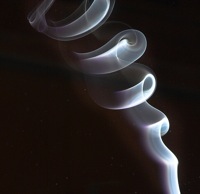Incense
Etymology
Middle English encens, from Anglo-French, from Late Latin incensum, from Latin, neuter of incensus, past participle of incendere to set on fire, from in- + -cendere to burn; akin to Latin candēre to glow
- Date: 13th century
Definitions
- 1 : material used to produce a fragrant odor when burned
- 2 : the perfume exhaled from some spices and gums when burned; broadly : a pleasing scent
- 3 : pleasing attention : flattery
Description
Incense (Latin: incendere, "to burn") is composed of aromatic biotic materials, which release fragrant smoke when burned. The term "incense" refers to the substance itself, rather than to the odor that it produces. It is used in religious ceremonies, ritual purification, aromatherapy, meditation, for creating a mood, masking bad odours, and in medicine. The use of incense may have originated in Ancient Egypt, where the gums and resins of aromatic trees were imported from the Arabian and Somali coasts to be used in religious ceremonies.
Incense is composed of aromatic plant materials, often combined with essential oils. The forms taken by incense have changed with advances in technology, differences in the underlying culture, and diversity in the reasons for burning it. The two main types can generally be separated into "indirect burning" and "direct burning". Indirect burning incense, also called "non-combustible incense", requires a separate heat source since it is not capable of burning itself. Direct burning incense, also called "combustible incense", is lit directly by a flame and then fanned out, the glowing ember on the incense will smoulder and release fragrance. Examples of direct burning incense are incense sticks (joss sticks) and cones or pyramids.
Incense Lore
Incense folklore includes art, culture, history, and ceremony. It can be compared to and has some of the same qualities as music, art, or literature. Incense is also an integral part of the tea ceremony, just like Calligraphy, Ikebana, and Scroll Arrangement. These are five Classical Chinese Arts. Incense Lore involves natural incense woods and not artificial substitutes.[1]
